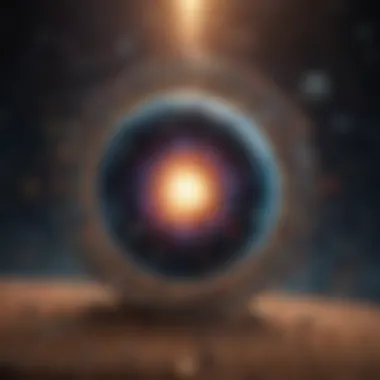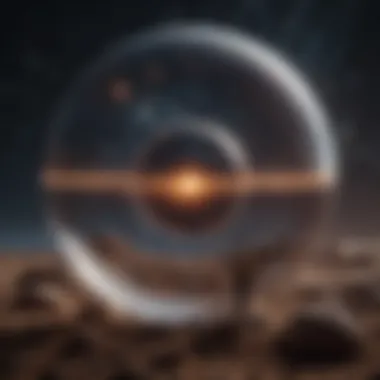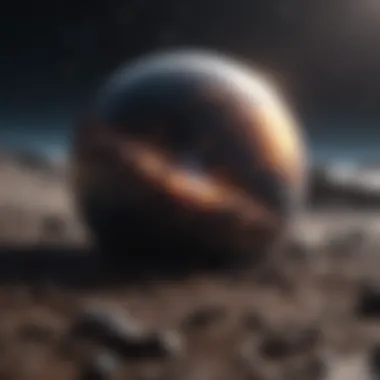Exploring the Origins of the Universe: Theories and Perspectives


Intro
The origins of the universe is a profound topic, attracting attention from scientists and philosophers alike. Understanding how everything began is not just an academic exercise; it shapes our comprehension of existence. There are many theories attempting to uncover this mystery. Key among these is the Big Bang theory. This theory posits that the universe started as a singularity, expanding rapidly over time. However, this is not the only idea in circulation. Alternative hypotheses, such as cosmic inflation and others, aim to explain the universe's beginnings from different angles.
The significance of these theories cannot be overstated. The investigation into the universe’s origins informs our knowledge of fundamental physics, cosmology, and the nature of reality itself. The outcomes of ongoing research have implications for how we view everything from the fabric of space-time to the potential existence of multiverses. We will dive into the key findings that have emerged from contemporary astrophysical research as we explore this exciting topic.
Key Research Findings
Recent discoveries in astrophysics continuously reshape our understanding of the cosmos. With advancements in technology, scientists are gathering more evidence than ever before. The findings contribute crucial insights into how the universe operates and originated.
Overview of Recent Discoveries
- Cosmic Microwave Background Radiation: This radiation presents a remnant from the Big Bang and is pivotal in supporting the theory. It is almost uniform across the sky, yet variations can inform us about early universe conditions.
- Hubble's Law: The observation that galaxies are receding from us at speeds directly proportional to their distance has been fundamental in supporting the expansion of the universe.
- Gravitational Waves: The detection of these waves opens a new window for observing cosmic events, offering fresh evidence related to significant conditions surrounding the origins of the universe.
Significance of Findings in the Field
Each research finding enhances our understanding of the universe. The evidence for cosmic expansion contradicts static models of the cosmos. Each discovery also influences philosophical discussions about the universe and existence.
Another significant point comes from the detection of gravitational waves. This breakthrough allows scientists to observe events that were previously invisible. It fosters new theories about the nature of black holes and singularities, as well as their potential roles in the universe's origin story.
"The ongoing pursuit of understanding our universe’s origins drives both scientific inquiry and deep philosophical questions about existence."
Breakdown of Complex Concepts
Theoretical concepts can often seem daunting. Distilling complex ideas into understandable formats is essential for broader accessibility.
Simplification of Advanced Theories
- The Big Bang Theory: Suggests the universe began as an infinitely dense point and expanded over time.
- Cosmic Inflation: Proposes a rapid expansion following the Big Bang, helping to explain the uniformity seen in the cosmic microwave background.
- Multiverse Hypothesis: Suggests there may be other universes beyond our observable one, each potentially operating under different physical laws.
Visual Aids and Infographics
Utilizing visual aids can aid in clarifying these advanced theories. Infographics could illustrate the timeline of the universe's expansion, explain the structure of cosmic microwave background radiation, or depict galaxies receding from Earth based on Hubble's Law. Such tools enhance comprehension and engagement with these complex ideas.
Foreword to the Universe's Origin
Understanding the origins of the universe is crucial for various reasons. It provides insights not only into the physical formation of the cosmos but also into the broader context of humanity's place within it. The theories that explain the very beginnings of existence help answer fundamental questions about our reality. From the details of cosmic formation to the nature of space and time, exploring these origins shapes our comprehension of existence itself.
At the core of this exploration, we find the question of how everything came to be. Are we alone in this universe? What are the underlying laws that govern everything around us? These questions lead to interdisciplinary dialogues among physicists, cosmologists, and philosophers, revealing the intricacies involved in understanding our cosmic neighborhood.
This article seeks to illuminate the significant theories that outline our universe's beginnings. Each theory has distinct implications and consequences for current scientific thought and philosophical discourse. Understanding these concepts is not just an academic exercise; it has far-reaching implications for future research, technological innovations, and our collective understanding of existence.
The Importance of Understanding Cosmic Beginnings
The search for cosmic origins has profound implications. Firstly, it enriches our scientific knowledge base. Knowledge about how the universe began informs us about the fundamental forces at play. This understanding has practical applications, influencing fields such as physics and engineering by guiding research and technological development.


Secondly, events like the Big Bang carry consequences that stretch across time. They serve as touchpoints for multiple theories that highlight our universe's behavior. Understanding these theories offers clarity on phenomena such as cosmic radiation and the structure of galaxies.
Finally, contemplating cosmic beginnings prompts introspection. It raises questions about existence, purpose, and our role in the universe. The implications reach beyond scientific inquiry, merging with philosophical considerations about life and existence, making the quest for cosmic understanding multifaceted and essential.
Historical Perspectives on the Universe's Start
The journey to comprehend the universe's beginnings is steeped in history. Early civilizations looked to the stars, crafting myths and stories that attempted to explain their existence. These narratives eventually led to more structured forms of thought, like those from ancient Greece, which pondered natural phenomenon and existence itself, but lacked empirical backing.
As time progressed, the scientific revolution heralded a new era. Figures like Copernicus and Galileo turned the examination of the cosmos toward empirical observation. This marked a decisive shift in humanity's understanding of our place in the universe.
With the development of modern astrophysics, theorists like Albert Einstein and Edwin Hubble laid the groundwork for contemporary understandings. The introduction of the theory of relativity and Hubble's discovery of galaxies moving away from us provided a scientific framework that echoed the stories of creation. The accumulation of interwoven histories culminates in our contemporary dialogue about cosmic beginnings.
“Knowing the history of the universe is crucial because it is not merely about how it started, but about how it evolves, affects us, and presents existential questions.”
In synthesizing these historical perspectives, we see how scientific advancements have been influenced by philosophical inquiries, reflecting humanity's enduring quest to grasp the ultimate nature of reality. This exploration not only enriches our knowledge but reaffirms our position as conscious observers of a vast and intricate universe.
The Big Bang Theory
The Big Bang Theory stands as a central pillar in modern cosmology. Not only does it propose the most widely accepted explanation for the origin of the universe, but it also invites a comprehensive examination of the universe's development over time. Understanding this theory is critical for grasping how structures such as galaxies, stars, and planets came into existence. Its implications extend far beyond the initial explosion. This theory provides insight into the physical processes that shaped the cosmic landscape.
Fundamentals of the Big Bang Model
The Big Bang Model describes the universe's expansion from a highly dense and hot initial state. This model suggests that roughly 13.8 billion years ago, the universe began to expand from an extremely small volume, leading to cooling and the gradual formation of fundamental particles. These particles eventually combined to create atoms, followed by molecules, stars, galaxies, and ultimately the large scale structure of the universe we observe today.
Key Evidence Supporting the Big Bang Theory
Cosmic Microwave Background Radiation
Cosmic Microwave Background Radiation (CMBR) is a critical component that supports the Big Bang Theory. It represents the afterglow of the initial explosion, filling the universe with a uniform glow detectable from every direction. The key characteristic of CMBR is its near-perfect black body spectrum, which indicates a temperature of about 2.7 Kelvin.
This feature makes CMBR a compelling piece of evidence for the Big Bang. It shows how the universe has cooled over time, and its uniformity aligns well with theoretical predictions. The advantage of CMBR in this discussion lies in its ability to provide a snapshot of the early universe, unlocking details about its composition and structure shortly after its formation.
Redshift of Galaxies
The redshift of galaxies observes how light stretches as it travels through an expanding universe. When astronomers measure this redshift, they find that distant galaxies are moving away from us, supporting the idea of expansion. The key aspect of this phenomenon is Hubble's Law, which correlates the speed of a galaxy's recession to its distance from Earth.
This makes redshift an essential evidence for the Big Bang. Its straightforward interpretation highlights the dynamic nature of the cosmos. The redshift demonstrates that the universe was once much smaller and more compact, and its unique feature is its application to various distances, providing a cohesive view of universal expansion.
Abundance of Light Elements
The abundance of light elements like hydrogen, helium, and lithium forms another pillar supporting the Big Bang Theory. According to the theory, these elements were created during the first few minutes after the Big Bang in a process known as Big Bang Nucleosynthesis. The key characteristic of this abundance is that it aligns closely with theoretical predictions and observed proportions.
This observation serves as another strong indicator of the Big Bang, showing the universe's evolutionary path. The unique feature lies in its predictability; researchers can calculate expected amounts of these elements based on the conditions of the early universe. Understanding their ratios helps us piece together the history of cosmic events.
The Role of Edwin Hubble


Edwin Hubble's contributions to the discourse on the Big Bang Theory cannot be understated. He pioneered the field of observational cosmology, allowing for the first systematic investigation of the universe's structure and its expansion. Hubble's observations of distant galaxies were groundbreaking. He demonstrated that most galaxies were receding from Earth, which implied that the universe is expanding. His work essentially provided the observational foundation upon which the Big Bang Theory would thrive. This was a pivotal moment in modern astronomy, underscoring the significance of his findings in shaping our understanding of the cosmos.
Cosmic Inflation
Cosmic inflation is a pivotal concept in cosmology that seeks to explain specific issues regarding the early universe. This theory postulates that a brief period of rapid expansion occurred just after the Big Bang. Understanding cosmic inflation provides insight into several unresolved questions about the universe. The significance of this theory lies in its ability to address certain inconsistencies that arise when observing the large-scale structure of the universe today.
Inflation proposes mechanisms that could potentially explain the uniformity of cosmic background radiation across vast distances. Moreover, it introduces a framework that unveils how small quantum fluctuations during this rapid expansion could lead to the structure we observe in the universe, such as galaxies and clusters of galaxies.
Concept and Development of Inflationary Theory
The concept of inflation originated in the 1980s, chiefly associated with physicist Alan Guth. The core idea is that the universe underwent exponential expansion for a fraction of a second immediately after the Big Bang. This phase of inflation would have stretched any initial irregularities to an even scale.
As a result, regions of the universe that are now vastly separated were once in close contact and would have shared similar physical conditions. This theory also proposes that, as the universe continued to expand, these regions cooled, leading to the formation of diverse structures we see in the present universe.
Implications for the Structure of the Universe
The implications of cosmic inflation are profound. It fundamentally alters how we understand the early universe and the distribution of matter. The rapid expansion helps to explain the large-scale homogeneity of the universe, a phenomenon referred to as the "flatness problem." Observations indicate that the universe is remarkably flat on a large scale, leading to questions on how such a state could arise without inflation.
Additionally, inflation accounts for the isotropy of cosmic microwave background radiation. This uniformity suggests that regions of space that are far apart share the same temperature and density, an unexpected behavior if not for the inflationary period.
Testing the Hypothesis of Inflation
Testing the hypothesis of inflation presents challenges but is crucial for validating or refuting the theory. Various scientific approaches exist to examine this concept. One method involves studying the cosmic microwave background radiation more closely. Scientists look for specific patterns, referred to as B-modes, which indicate gravitational waves created during inflation.
Other tests include observations of the large-scale structure of the universe. The theory predicts certain distributions and correlations of galaxies that can be examined through observational data from telescopes like the Hubble Space Telescope.
Alternative Theories of Cosmic Origins
Alternative theories of cosmic origins hold a significant place in our understanding of the universe. While the Big Bang theory dominates discussions, these alternatives encourage deeper investigation of the universe's inception. They challenge assumptions and force scientists to rethink cosmological concepts. Understanding these theories is essential. They highlight the complexity and richness of the cosmos, stimulating scientific exploration.
Steady State Theory
The Steady State Theory posits that the universe is eternal and unchanging. Instead of a singular beginning, this theory suggests a constant creation of matter to maintain a steady density. Proposed by Fred Hoyle, Thomas Gold, and Hermann Bondi in 1948, it was a response to the observations suggesting an expanding universe. Proponents argue that the observable universe has always existed, thus transcending the necessity for a specific origin.
Despite its intuitive appeal, the Steady State Theory struggled with empirical evidence. The discovery of Cosmic Microwave Background Radiation presented a challenge to its validity. In contrast to the predictive models of the Big Bang theory, it lacked robust support. Nonetheless, this theory stimulated discussions about cosmic evolution and the nature of time.
Multiverse Hypothesis
The Multiverse Hypothesis introduces the concept of multiple universes existing simultaneously, each with its own physical laws and constants. This theory emerges from interpretations of quantum mechanics and cosmic inflation, suggesting an infinite collection of universes, or a 'multiverse.' In this context, our observable universe is just one among many, each arising from different quantum fluctuations during the universe's expansion.
Philosophically, the implications are profound. If every possible event occurs in some universe, it raises questions about fate and free will. The Multiverse Hypothesis invites imaginations but also challenges traditional notions of experimentation and verification in science. Critics argue that it lacks testability, making it difficult to falsify.
Quantum Fluctuations and Vacuum States
Quantum fluctuations refer to temporary changes in the amount of energy present in a point in space. This concept implies that fluctuations could lead to small regions of space expanding rapidly, thereby creating universes. In quantum field theory, vacuum states arise as the lowest energy states. They suggest a dynamic background where particles constantly flicker in and out of existence.


Using these fluctuations, some theories propose that they might be the seeds for universe formations. Vacuum fluctuations could initiate cosmic inflation, offering an explanation for the uniformity and structure of the cosmos. This perspective reconciles quantum mechanics with cosmological models, broadening our understanding of cosmic origins.
"The universe may be a vast ensemble of random fluctuations, generating a diverse array of cosmic environments."
The discourse around alternative theories embodies the intricate dance of scientific inquiry. It reflects the hub of creativity and logical reasoning that pushes the boundaries of human understanding.
Philosophical Implications of the Universe's Origin
Understanding the origin of the universe goes beyond scientific inquiry. It taps into profound philosophical questions about existence, reality, and the nature of being. The discussion around the universe's origin invites us to ponder our place in the cosmos and considers what it means to exist in a vast and possibly infinite universe. This aspect is essential for students, researchers, and educators as it fosters a deeper reflection not only on what we know about the cosmos but also on the implications of that knowledge.
Additionally, philosophical implications may influence our interpretation of scientific theories. For example, theories like the Big Bang or cosmic inflation propose mechanisms of creation. Yet, they raise questions about the cause of the universe itself. Is there a purpose behind the universe’s existence? Are humans significant in the grand scheme of things? These are existential questions that arise and can influence how we live and understand our surroundings.
"Philosophy and cosmology intersect where science ends, often leading to more questions than answers."
Existential Questions Raised by Cosmology
Cosmology prompts an array of existential questions. At the forefront, we ask: Why is there something rather than nothing? This fundamental question confronts us with the mystery of existence itself. As humans, we seek to find meaning in our lives and the universe. Do the vastness and complexity of the universe suggest that existence is a grand coincidence, or is there an underlying purpose?
Moreover, the exploration of the universe can lead to realization about our fragility and transience. In contemplating the scale of the cosmos, individuals often reflect on their personal lives and the impact of human actions. For example, does our search for knowledge contribute to or detract from our well-being?
The Intersection of Science and Philosophy in Cosmology
The interplay between science and philosophy in cosmology is particularly noteworthy. While science provides frameworks and models to explain cosmic phenomena, philosophy analyzes the implications of these models. Philosophers examine concepts like time, space, and the nature of reality as understood through scientific perspectives. They ask not only how the universe began but also what the implications of that beginning mean for our understanding of existence.
In recent decades, debates have emerged around topics such as the multiverse hypothesis and its philosophical implications. If multiple universes exist, what does that mean for our understanding of chance and determinism? Furthermore, as scientists propose new theories, philosophers consider how these ideas might reshape ethical and ontological perspectives.
This collaboration enriches our understanding and helps to bridge gaps in our knowledge. It shows that the pursuit of knowledge is not just confined to empirical evidence but also encompasses the broader inquiries about reality and humanity’s role in it.
In essence, the study of the universe's origin interweaves scientific inquiry with philosophical exploration. Both realms contribute to a more comprehensive understanding of our existence in this expansive, mysterious cosmos.
Epilogue: The Ongoing Quest for Understanding
In the ever-evolving field of cosmology, the quest to understand the origins of the universe remains a fundamental topic. This pursuit is not merely academic; it shapes our understanding of existence itself. The investigation into how the universe began has implications for various disciplines, including physics, philosophy, and even theology. Examining these origins helps scientists and thinkers alike to propose theories that can withstand scrutiny and adapt to new evidence.
The conclusions drawn from our exploration of the universe are both essential and tentative. Theories such as the Big Bang and cosmic inflation have provided frameworks to interpret diverse phenomena. Nevertheless, several important questions continue to motivate research. What lies beyond the observable universe? Can alternative theories unravel aspects of cosmic origins that traditional models cannot? Addressing these outstanding inquiries is paramount for advancing our comprehension of the cosmos.
Future Directions in Cosmology Research
As we look ahead, the future of cosmology research is promising yet challenging. The advancement of technology allows telescopes and satellites to probe deeper into space than ever before. Instruments specializing in observing cosmic microwave background radiation or studying gravitational waves promise to yield fresh insights. Specifically, future missions like the James Webb Space Telescope aim to investigate early galactic formations and provide evidence for theories of cosmic evolution.
Additionally, researchers are considering how quantum physics interacts with cosmology. Concepts like quantum fluctuations may unlock new understandings of the universe’s inception. Furthermore, interest in dark matter and dark energy continues to grow, as these entities constitute a significant portion of the cosmos yet are poorly understood.
The Importance of Interdisciplinary Collaboration
Interdisciplinary collaboration will be key to enhancing understanding of the universe's origins. Engaging experts from physics, philosophy, and even art can lead to richer discussions and insights. For instance, collaboration between astronomers and computer scientists can improve data analysis techniques, leading to more accurate models. Likewise, philosophers can contribute by exploring the implications of cosmological discoveries on human existence and purpose.
Encouraging partnerships across diverse fields broadens the scope of inquiry. When scientists combine their methodologies and perspectives, the complexity of cosmic origins can be better grasped. This collaborative effort may also inspire innovative solutions to longstanding problems in cosmology.
"In seeking to understand the origins of the universe, we are, in essence, seeking to understand ourselves."
In summary, the ongoing quest to explore the universe's origins remains vital. It fosters critical discourse on existential questions, stimulates scientific innovation, and establishes connections across various disciplines. As humanity continues to delve deeper into this monumental investigation, the dialogue between science and philosophy will likely enhance perspectives on our place in the universe.















